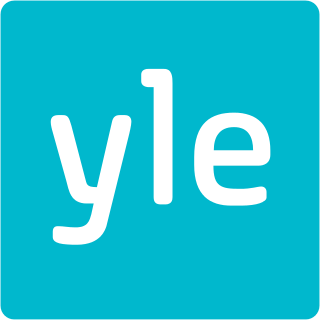Prime time or the peak time is the block of broadcast programming taking place during the middle of the evening for a television show. It is mostly targeted towards adults. It is used by the major television networks to broadcast their season's nightly programming. The term prime time is often defined in terms of a fixed time period—for example, from 8:00 p.m. to 11:00 p.m. or 7:00 p.m. to 10:00 p.m.. In India and some Middle Eastern countries, prime time consists of the programmes that are aired on TV between 8:00 p.m. and 10:00 p.m. local time.

NRK, an abbreviation of the Norwegian Norsk Rikskringkasting AS, generally expressed in English as the Norwegian Broadcasting Corporation, is the Norwegian government-owned radio and television public broadcasting company, and the largest media organisation in Norway. All other TV channels, broadcast from Norway, were banned between 1960 and 1981. NRK broadcasts three national TV channels and thirteen national radio channels on digital terrestrial television, digital terrestrial radio and subscription television. All NRK radio stations are streamed online at NRK.no, which also offers an extensive TV service. NRK is a founding member of the European Broadcasting Union.

Yleisradio Oy, translated to English as the Finnish Broadcasting Company, is Finland's national public broadcasting company, founded in 1926. It is a joint-stock company which is 99.98% owned by the Finnish state, and employs around 3,200 people in Finland. Yle shares many of its organizational characteristics with its British counterpart, the BBC, on which it was largely modelled.

Sveriges Television AB, shortened to SVT, is the Swedish national public state-controlled television broadcaster, funded by a public service tax on personal income set by the Riksdag. Prior to 2019, SVT was funded by a television licence fee payable by all owners of television sets. The Swedish public broadcasting system is largely modelled after the system used in the United Kingdom, and Sveriges Television shares many traits with its British counterpart, the BBC.
TV 2 is a Norwegian terrestrial television channel. Its headquarters are located in Bergen. TV 2 began test broadcasting on 13 November 1991, and a year later, it was officially launched on 5 September 1992, becoming Norway's first commercial free-to-air television channel. In 1992, TV 2 A/S was admitted as full active member of the European Broadcasting Union.

NRK1 is the Norwegian Broadcasting Corporation's (NRK) main television channel.

NRK2 is one of the TV channels of the Norwegian Broadcasting Corporation (NRK). It was launched on 1 September 1996.
Norges Televisjon AS, or NTV, operates the digital terrestrial television (DTT) network in Norway. The infrastructure is owned by the Telenor-subsidiary Norkring, while the content is provided by the Norwegian Broadcasting Corporation (NRK) and RiksTV. The company is owned in equal parts by NRK, TV 2 and Telenor. The same companies also own RiksTV. RiksTV offers a range of pay television channels.
NRK Super is a Norwegian TV & radio channel aimed at children, run by the Norwegian Broadcasting Corporation. The TV channel is broadcast on the digital terrestrial network, on the same frequency as NRK3 from 7am to 7pm, and was launched 1 December 2007. The NRK Super radio channel is broadcast on DAB radio and the internet, and was originally named NRK Barn. It was launched on 16 October 2007.
Television in Norway was introduced in 1954, but the first television program was only shown in 1958, and regular broadcasts did not start until 1960. Like Denmark, Norway had only one television channel until the 1980s. Some 40% of the population have cable TV, and 30% have satellite TV. Another 30% have terrestrial television only.
Dagsnytt is Norwegian public radio's main news programme. It is broadcast on most of NRK radio channels, with bulletins every hour and longer programmes four times a day. It has about 2,5 million daily listeners, around half of the Norwegian population.

Norkring AS is a provider of digital terrestrial television and radio transmitting in Norway and Belgium. In Norway, Norkring operates a Digital Video Broadcasting – Terrestrial (DVB-T) network for Norges Televisjon, as well as an FM and Digital Audio Broadcasting (DAB) radio. In Belgium, Norkring operates a DVB-T, DVB-T2, FM, DAB and DAB+ network. It operated a DVB-T network in Slovenia between 2010 and 2012. Norkring is owned by Telenor; Norkring België is owned 75 percent by Norkring and 25 percent by Participatiemaatschappij Vlaanderen.

Dagsrevyen is the daily evening news programme for the Norwegian television channel NRK1, the main channel of the Norwegian Broadcasting Corporation (NRK), broadcast at 19:00. In 2007, the programme started airing simultaneously on NRK's dedicated news channel NRK2, but this arrangement ended that same year. Dagsrevyen's first newscast was broadcast in 1958 and it has kept its name since. It is Norway's most viewed programme, with daily ratings of around one million. Around 200 people are involved in its production, with headquarters at Marienlyst in Oslo.

NRK Sápmi is a unit of the Norwegian Broadcasting Corporation (NRK) that streams news and other programs in the Sami language for broadcast to the Sami people of Norway via radio, television, and internet. Regular radio news programs in Sami began in 1946, presented from Tromsø by the teacher Kathrine Johnsen (1917–2002), remembered today as "Sami Radio's Mother".
Mass media in Norway outlines the current state of the press, television, radio, film and cinema, and social media in Norway.
In broadcasting, continuity or presentation is announcements, messages and graphics played by the broadcaster between specific programmes. It typically includes programme schedules, announcement of the programme immediately following and trailers or descriptions of forthcoming programmes. Continuity can be spoken by an announcer or displayed in text over graphics. On television continuity generally coincides with a display of the broadcaster's logo or ident. Advertisements are generally not considered part of continuity because they are advertising another company.
Slow television, or slow TV, is a term used for a genre of "marathon" television coverage of an ordinary event in its complete length. Its name is derived both from the long endurance of the broadcast as well as from the natural slow pace of the television programme's progress. It was popularised in the 2000s by the Norwegian Broadcasting Corporation (NRK), beginning with the broadcast of a 7-hour train journey in 2009.

NRK News is the Norwegian Broadcasting Corporation's news organisation. It produces news around the clock for radio and television in Norwegian and Sami. There are two main newsrooms, one for radio and one for television ; both are headquartered in the Norwegian capital Oslo. NRK also produces local news bulletins at newsrooms around the country. Internationally, NRK correspondents are based in Washington, D.C., Nairobi, Beijing, London, Moscow, Brussels, Berlin and Istanbul. Urix, produced by NRK News, is a television program that specializes in international news.

Oslo Metropolitan University is a state university in Oslo and Akershus in Norway. It is the result of the merger of many former vocational colleges in the Greater Oslo Region. It has around 1,400 academic employees, around 20,000 students and around 800 administrative support staff.










